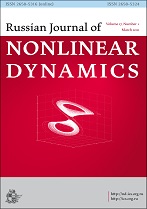|
Nonlinear physics and mechanics
Rotation of a Planet in a Three-Body System:
a Non-Resonant Case
O. M. Podvigina
Institute of Earthquake Prediction Theory and Mathematical Geophysics, RAS,
ul. Profsoyuznaya 84/32, Moscow, 117997 Russian Federation
Abstract:
We investigate the temporal evolution of the rotation axis of a planet in a system comprised
of the planet (which we call an exo-Earth), a star (an exo-Sun) and a satellite (an exo-Moon).
The planet is assumed to be rigid and almost spherical, the difference between the largest and
the smallest principal moments of inertia being a small parameter of the problem. The orbit
of the planet around the star is a Keplerian ellipse. The orbit of the satellite is a Keplerian
ellipse with a constant inclination to the ecliptic, involved in two types of slow precessional
motion, nodal and apsidal. Applying time averaging over the fast variables associated with the
frequencies of the motion of exo-Earth and exo-Moon, we obtain Hamilton’s equations for the
evolution of the angular momentum axis of the exo-Earth. Using a canonical change of variables,
we show that the equations are integrable. Assuming that the exo-Earth is axially symmetric
and its symmetry and rotation axes coincide, we identify possible types of motions of the vector
of angular momentum on the celestial sphere. Also, we calculate the range of the nutation angle
as a function of the initial conditions. (By the range of the nutation angle we mean the difference
between its maximal and minimal values.)
Keywords:
nutation angle, exoplanet, averaging, Hamiltonian dynamics.
Received: 03.07.2022
Accepted: 22.08.2022
Citation:
O. M. Podvigina, “Rotation of a Planet in a Three-Body System:
a Non-Resonant Case”, Rus. J. Nonlin. Dyn., 18:4 (2022), 527–541
Linking options:
https://www.mathnet.ru/eng/nd809 https://www.mathnet.ru/eng/nd/v18/i4/p527
|

| Statistics & downloads: |
| Abstract page: | 75 | | Full-text PDF : | 36 | | References: | 27 |
|




 Contact us:
Contact us: Terms of Use
Terms of Use
 Registration to the website
Registration to the website Logotypes
Logotypes









 Citation in format
Citation in format 